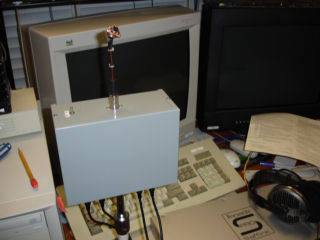|
|
Project #1 - Ambisonic Microphone |
It is the ACTLab environment that keeps me coming
back for more opportunities to build stuff.
With Soundscapes as the topic, I am in
high-cotton. And so, a project like this one
is complementary to some of my prior projects.
This project involved building the microphone and the preamplifiers, including the B-format matrix and output amplifiers, based on a description by Henry J. Walmsley. I found several websites describing the tetrahedral microphone assembly, including pictures of commercial soundfield microphones (complete with the grandaddy soundfield of them all, the Soundfield™, without its screen). I chose some Panasonic back electret microphone capsules (WM-55A103) and found them available for $2.25 each. How much quality could I expect? As it turned out, not bad for nine dollars worth of microphone capsules. Building the preamps was the easier part of the construction. Assembling a tetrahedral from 3/4-inch pieces of AWG12 copper wire was challenging. Ambisonics seems to be in the realm of academics |

The first sounds recorded were of my cat Snickers and the chimes of my pendulum clock. |
and experimenters, especially in the United States.
Much of the development of amibisonics was by the
late British mathematician and audio engineer,
Michael Gerzon, inventor of the Soundfield™
microphone.
For further studies on ambisonic microphones, see Blackbox - Fall 2009 and Ambisonics . |